Spirited Away – Himalayan Masking Traditions
PRIMITIVE - Friday, August 14, 2015By Misaki Imagawa
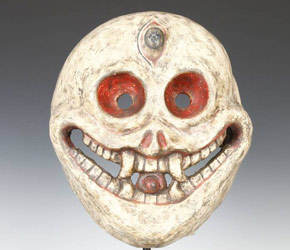 |
|
| Even in daylight, this Citipati mask from Tibet may appear frightening to the unfamiliar; PRIMITIVE ID# A0702-267 |
In the flickering light of a dozen butter lamps, the sight of dancing, masked demons could scarcely be seen. Their shadows moved in an unnatural, eerie fashion. If your eyes adjusted, you could see open mouths grinning and laughing along with eyes bulging and gleaming in a menacing manner. Yet, none of what you saw was a cause for concern. As an audience member you sat unafraid, deep in the mountains of the Himalayas, enjoying a traditional masked dance. You might even lean forward, a smile tugging at your lips in delightful awe.
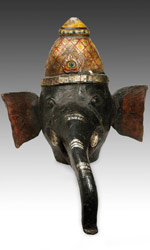 |
|
| Festival mask from India depicting Ganesh; PRIMITIVE ID# A0607-1695 |
For many years, the masking traditions of the Himalayas remained obscure and hidden from the West. While African and Southeast Asian art had become highly collectible by the early 20th century, it took another 60 or 70 years until the art from the remotest regions of Nepal and Tibet were recognized. Of particular interest to collectors and scholars were Himalayan masks. Even today, information regarding Himalayan masking traditions is still scarce due to fading oral traditions and inconsistent accounts attributed to multiple ethnic groups – all in a region that stretches across five countries. However, in general it appears that there are two main categories of Himalayan masks: those related to Buddhism and Hinduism; and those related to indigenous animist traditions. One thing is certain; all Himalayan masks are oriented toward religious traditions.
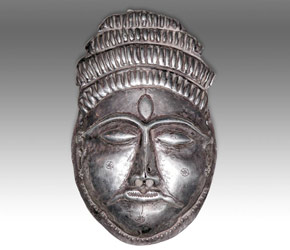 |
|
| Silver 19th C. mask depicting the Hindu God Shiva; PRIMITIVE ID# A0309-324 |
Masks based on Buddhism and Hinduism are more widely recognized and understood. They depict deities of the Buddhist pantheon, including wrathful deities such as Mahakala, who ferociously defends Buddha's teachings. The masks also represent Hindu gods and goddesses as well as popular characters from epics like the Ramayana and Mahabharata. To this day, such masks are popular at religious masquerades such as the Cham Dance, a lively costumed dance associated with some sects of Tibetan Buddhism. Yet, the masking tradition of the Himalayas existed long before either Buddhism or Hinduism was adopted.
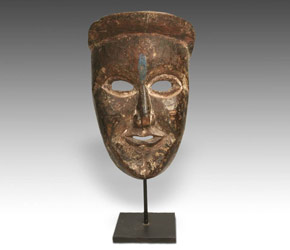 |
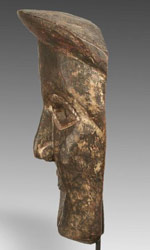 |
||
| Carved wood Shaman's mask from Nepal; PRIMITIVE ID# A0404-975 | |||
Surrounded by rugged mountains, at the mercy of the wild, the ancient people of the Himalayas worshiped nature and its animals. Often, this worship focused on spirits. In some cases, masks associated with this worship appeared ominous and threatening because their purpose was to drive away evil spirits by striking terror into them. Usually, such masks represented local demons that shamans had subdued and turned into protective deities, still brandishing their menacing appearances. Compared to Buddhist and Hindu masks, which were required to follow strict canonical rules of depiction, tribal masks were bound to no such requirements. Many Himalayan tribal masks depict animals in ways that are unique to the style of the carvers. Craftsmen were free to exercise their artistic liberties and infuse the masks with unrestrained creativity and expression, an aura that remains to this day and is found in the details of these artworks.
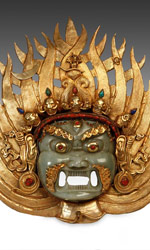 |
|
| Jewel encrusted jade gilt mask depicting Bhairab, Guardian of the Kathmandu Valley; PRIMITIVE ID# A1105-232 |
Unlike a majority of wooden masks from other areas of the world, Himalayan masks age remarkably well. The virtual absence of high humidity and insect pests, the two main agents of the destruction of wood, which are not found in the altitude of the Himalayas, allowed wood masks of significance to survive. Often times, these masks were passed down from generation to generation for hundreds of years. They became considered auspicious and were believed to contain protective powers. They were cared for meticulously and typically rubbed with butter to retain a shiny patina. Frequent use in performances and rituals also ensured their powers remained sanctified.
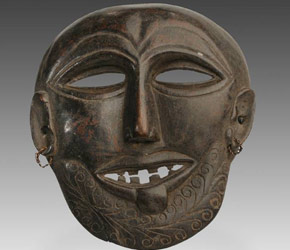 |
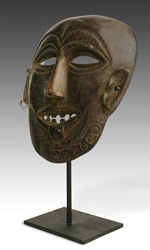 |
||
| Spirit mask from the Madhesi people of Southwest Nepal; PRIMITIVE ID# A0607-365 | |||
Illuminated by moon and firelight, what were the masqueraders depicting? Who were their masks meant to illustrate? Perhaps they were reenacting their ancestors' exploits, commemorating a clan hero or even celebrating a wedding. We cannot know with certainty in all cases, as the full knowledge of these masking traditions may forever be lost. Yet, the absence of definitive information does not take away from our appreciation of these artworks. One thing is certain, arresting and evocative, these masks have the capacity to spirit you away to cultures hidden deep in the heart of the Himalayas.
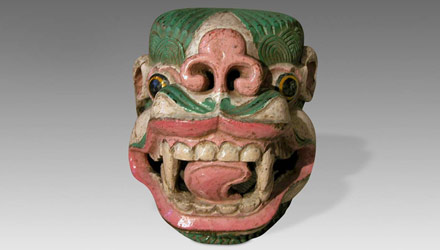 |
| This Tshechu, or festival mask, is an integral part of the Cham Dance, and part of a much larger collection of masks available exclusively at PRIMITIVE |
Download this Article: Spirited Away - Himalayan Masking Traditions.pdf